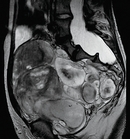Ultrasound vs. MRI for Imaging of the Female Pelvis
Thursday, Nov. 30, 2017
When it comes to imaging the pelvis, radiologists agree that ultrasound (US) is the right tool for diagnosis. However, opinions diverge on when MRI should be used, and the topic was debated during a Wednesday Controversy Session.

(A) A complex cystic mass in the ovary in a patient with pelvic pain. The mass is non-specific, however the color Doppler image (B) shows the characteristic "ring of fire" configuration of blood flow making the diagnosis unequivocally a corpus luteum. -- Image credit: Beryl R. Benacerraf, MD
"In a skilled hand and using all the techniques that are available to the sonologist, ultrasound can localize sources of pelvic pain and discomfort and performs equally, if not better than MRI," said Beryl Benacerraf, MD, from Brigham and Women's Hospital and Harvard Medical School in Boston.
Deborah Levine, MD, from Beth Israel Deaconess Medical Center and Harvard Medical School in Boston, agreed that US is where radiologists should begin and finish with pelvic imaging, but added that in some instances more information is needed. "Pelvic MRI is a problem solving tool that should be used when an US is inconclusive about diagnosis or doesn't provide enough information to confirm treatment direction," Dr. Levine said.

Young woman with multiple fibrous lesions in her pelvis seen on ultrasound and ectatic thecal sac due to unexpected neurofibromatosis. Diagnosis was made by MRI. (Click or tap to view larger) -- Image credit: Deborah Levine, MD
For Dr. Benacerraf, technical advances, such as 3-D, color Doppler and real-time transvaginal dynamic US, make US an effective imaging tool for gynecologic patients. "These additional technologies add value, but only when the radiologist is in the room examining the patient simultaneously and uses the advances to tailor the imaging based on what the patient says," Dr. Benacerraf said.
There are instances though, countered Dr. Levine, when US doesn't provide a sufficiently complete picture of the nature of a mass or when there are complications during pregnancy.
"MRI can give additional information about the nature of a mass that may change the decision to perform surgery, such as when the mass is an exophytic fibroid," Dr. Levine said. "When uterine artery embolization is planned, MRI can show the exact number, size and location of fibroids or guide decisions regarding a hysteroscopy or laparoscopic approach."
In pregnancy, Dr. Levine noted, MRI is helpful when there is a suspicion of fetal abnormality or prior to fetal surgery, when the surgeon wants to be sure that the abnormality being treated is the only one present.
In conclusion, Dr. Levine affirmed that there is a place for MRI when imaging the female pelvis. "When surgical intervention is being considered, MRI can provide additional information that confirms or alters the direction of treatment," she said. "It can also assist with patient counseling, in situations where more detail is needed, or where reassurance is needed about the conservative management of benign masses."
According to Dr. Benacerraf, US can provide a diagnostic answer without the need for further testing. "If we continue as a profession to end so many ultrasound reports with 'MRI is recommended,' requesting physicians and payers may become disenchanted with ultrasound as a modality thus decreasing its value," she said. "Consequently we need to provide adequate training and maintenance of competency in order to ensure that all ultrasound procedures are performed with high quality resulting in confident diagnoses."

From left, Beryl R. Benacerraf, MD, Deborah Levine, MD, and Carol B. Benson, MD, moderator.




 Home
Home Program
Program
 Exhibitors
Exhibitors My Meeting
My Meeting
 Digital Posters
Digital Posters Case of Day
Case of Day

